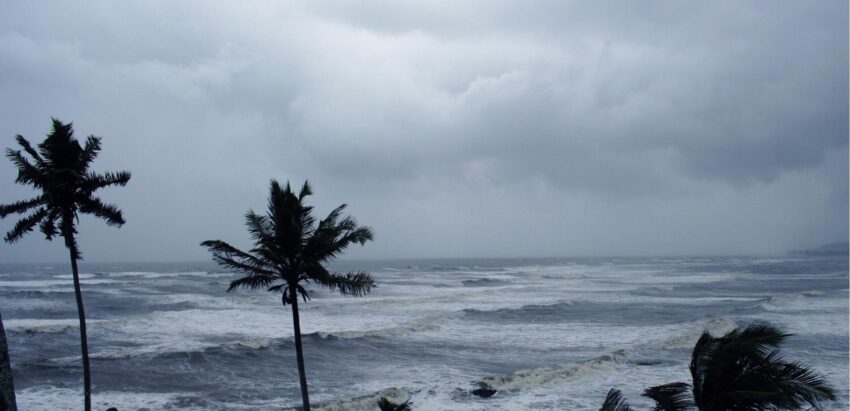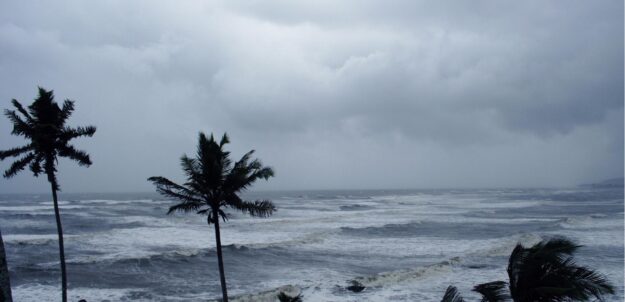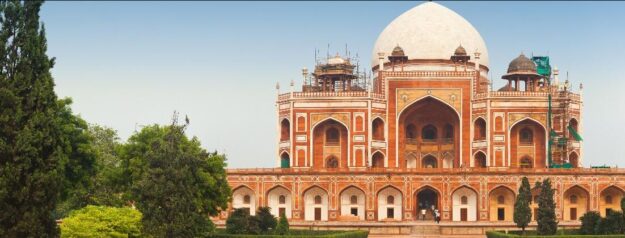The climate in India is different. Due to the size of the country and the geographical conditions, parts of the country have a tropical climate , while other regions belong to the temperate climate zone. In the south it is tropical hot all year round. In the north, however, there are strong temperature fluctuations over the year. The differences are 10 degrees Celsius in December and up to 50 degrees Celsius in July. The monsoons of India strongly influences the climate of the country. The year can be divided into summer, winter and rainy season. Summer lasts from March to May and winter from November to February. In between, the monsoon arrives in India and sometimes brings with it large amounts of rain. Read on to find out more about the Indian monsoons. According to Countryaah.com, India is one of countries starting with letter I.
The monsoons of India
In summer there is the southwest monsoon and in winter the northeast monsoon. The summer monsoon brings heavy rainfall, which can lead to massive flooding. This forms the rainy season and lasts from June / July to September / October . The west coast of India and northeast India are hardest hit by the monsoons. The country’s mountainous regions are also heavily influenced by the summer monsoon. The Himalayas and the Western Ghats form a natural barrier for the rain clouds, which therefore rain down on the slopes of the mountains. Winter consumption , coming from the northeast, brings cold and dry air with it. This replaces the summer monsoon in September / October and lasts until June / Julyat. During these months there are periods of drought in the country. The southeast, on the other hand, receives rain from the northeast monsoon. Because the monsoon stores moisture from the Bay of Bengal, which it brings to the southeast. In the following I provide you with climate tables for different regions of India. So you can see at a glance what weather awaits you during your trip.
How is the climate in the north?
The climate of North India is subtropical . Using a climate table for the capital New Delhi, I will explain to you what weather awaits you in this part of the country. The temperature differences are very pronounced in the north of India. December is the coldest month of the year in this region . Average lows of 7 degrees Celsius are reached at night. During the day it is 21 degrees. In the summer month of June, the thermometer climbs to a hot 39.5 degrees Celsius. The least rainfall falls in November. This month it rains an average of 0 days. In December, January and April you can expect 1 rainy day and in February, March, May and October 2 rainy days. Between June and September, the monsoons affect the northern climate. It reaches its zenith in August. Here an average of 261 millimeters of precipitation falls on 11 days.
In July the value is 13 rainy days, but the amount of precipitation in this month is lower than in August. The sun shines an average of 5 to 9 hours. The maximum of 9 hours of sunshine is reached in April and October, with the least amount of sunshine in July. The best time to travel to northern India is from October to March. Due to its climatic conditions, this period is best suited for a vacation in the land of contrasts. It’s sunny with 7 to 9 hours of sunshine and temperatures are between 21 and 33 degrees Celsius.
Climate table New Delhi
| Jan | Feb | March | Apr | May | Jun | Jul | Aug | Sep | Oct | Nov | Dec | |
| Max. Temperature in ° C | 21 | 24 | 29 | 36 | 39 | 39.5 | 35 | 34 | 34 | 33 | 28 | 23 |
| Min. Temperature in ° C | 7 | 10 | 15 | 22 | 26 | 28 | 27 | 26 | 25 | 20 | 13 | 9 |
| Hours of sunshine per day | 7 | 8 | 8 | 9 | 8.5 | 7 | 5 | 6 | 7 | 9 | 8 | 7 |
| Rainy days per month | 1 | 2 | 2 | 1 | 2 | 6 | 13 | 11 | 6 | 2 | 0 | 1 |
| Precipitation in mm | 18 | 20 | 16 | 17 | 26 | 71 | 226 | 261 | 125 | 17 | 6 | 11 |
How is the climate in the south?
So that you can get a good impression of the climatic conditions in the south, I am providing you with a climate table for Madurai . The two thousand year old city is located in the southern Indian state of Tamil Nadu. The climate in this part of the country is tropical . Temperatures are hot all year round. January is the coldest month with a maximum of 30 degrees Celsius and a minimum of 21 degrees. The highest temperatures expect you in May. This month the thermometer climbs to an average of 37 degrees Celsius. January and February bring the most hours of sunshine – 9 in number – with them. With 5 hours a day, the sun shines the least in June, July and August. Between January and July, the number of rainy days is between 2 and 4 days per month. The amount of precipitation is also low during this period.
The values increase from August and reach their maximum in October. This month it rains 12 days. I recommend December to February as the best travel time for southern India . During this time, the temperatures are most pleasant with an average of 30 to 32 degrees Celsius and the probability of rain is very low. The monsoon only affects the south from August to November. Therefore it is also dry from March to July. However, the temperatures are very high during this period. Vacationers who do not mind hot and humid temperatures can also travel to India during these months.
Climate table Madurai
| Jan | Feb | March | Apr | May | Jun | Jul | Aug | Sep | Oct | Nov | Dec | |
| Max. Temperature in ° C | 30 | 32 | 35 | 36 | 37 | 36 | 35 | 35 | 35 | 33 | 31 | 30 |
| Min. Temperature in ° C | 21 | 22 | 23 | 25 | 26 | 26 | 26 | 25 | 25 | 24 | 23 | 22 |
| Hours of sunshine per day | 9 | 9 | 8 | 7 | 6 | 5 | 5 | 5 | 6 | 6 | 6 | 7 |
| Rainy days per month | 2 | 2 | 2 | 4 | 4 | 3 | 4 | 7 | 9 | 12 | 9 | 7 |
| Precipitation in mm | 14 | 9 | 16 | 58 | 69 | 40 | 60 | 95 | 109 | 182 | 133 | 61 |
What is the climate like on the west coast?
Representing the climate on the west coast of India, I present you the climate diagram of the port city of Mumbai . This part of the country has a tropical climate. The temperatures fluctuate only slightly over the year. The warmest month is May with a maximum of 34 degrees Celsius during the day and minimum temperatures of 27 degrees Celsius. Hot temperatures await you in April as well. The coolest month is January with temperatures between 19 degrees Celsius at night and an average of 30 degrees Celsius during the day. The number of hours of sunshine varies greatly. In April and May the sun shines the longest at 10 hours. In contrast, the months of July and August bring only 2 hours of sunshine. Due to the Western Ghats – a mountain range in western India – the coastal plains are mostly protected from rain and almost free of precipitation between October and May.
The monsoons sweep this part of the country from June to September, bringing heavy rains with it. The monsoon reaches its zenith in July and brings 26 days of rain to the west coast of India. I recommend the months of October to March as the optimal travel time for the Indian west coast .
Climate table Mumbai
| Jan | Feb | March | Apr | May | Jun | Jul | Aug | Sep | Oct | Nov | Dec | |
| Max. Temperature in ° C | 30 | 30 | 31 | 33 | 34 | 32 | 30 | 30 | 31 | 33 | 33 | 32 |
| Min. Temperature in ° C | 19 | 20 | 23 | 25 | 27 | 26 | 25 | 25 | 25 | 25 | 23 | 21 |
| Hours of sunshine per day | 9 | 9 | 9 | 10 | 10 | 5 | 2 | 2 | 5.5 | 8 | 8 | 8 |
| Rainy days per month | 0 | 0 | 0 | 0 | 0 | 16 | 26 | 20 | 14 | 3 | 1 | 0 |
| Precipitation in mm | 0 | 0 | 0 | 2 | 12 | 581 | 791 | 531 | 298 | 69 | 15 | 4 |
What is the climate like in the Himalayas?
Based on the city of Leh, which is 3,500 meters high, I will show you the climate of the Himalayan regions of India. Leh is the capital of Ladakh and a district in the state of Jammu and Kashmir. Temperatures in this area fluctuate greatly over the year. The coldest month is January with -5 degrees Celsius during the day and -14 degrees at night. On the other hand, it gets warmest in July. Average temperatures of 25 degrees Celsius are reached here. This maximum temperature may sound pleasant. Please note, however, that the temperatures are perceived as hotter due to the altitude. Are you traveling for a trekking tour in this area? Then don’t forget to pack a hat for your hike. The first snowflakes fall in the Himalayas from the beginning of October.
It often snows heavily in this region between November and early June. The number of hours of sunshine is between a minimum of 6 in January and a maximum of 10 in July. Rain almost never awaits you in Leh. With 0 to 1 rainy day, it is dry all year round. The amount of precipitation is also very low with a maximum value of 41 millimeters on average. However, do not rely too much on the climate data. Because the weather in this region is often unpredictable. So pack rainproof clothing as a precaution. The best travel period for the Himalayan region is from July to October.
Climate table Leh
| Jan | Feb | March | Apr | May | Jun | Jul | Aug | Sep | Oct | Nov | Dec | |
| Max. Temperature in ° C | -5 | -2 | 6 | 12 | 17 | 21 | 25 | 24 | 21 | 14 | 8 | 2 |
| Min. Temperature in ° C | -14 | -12 | -6 | -1 | 3 | 7 | 10 | 10 | 5 | -1 | -7 | -11 |
| Hours of sunshine per day | 6 | 7 | 6 | 8 | 8 | 9 | 10 | 9 | 9 | 8 | 8 | 7 |
| Rainy days per month | 1 | 1 | 1 | 1 | 1 | 0 | 1 | 1 | 1 | 0 | 1 | 1 |
| Precipitation in mm | 11 | 12 | 14 | 15 | 19 | 27 | 33 | 41 | 12 | 3 | 9 | 10 |


